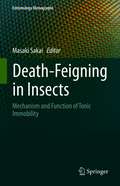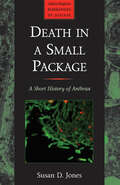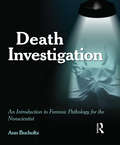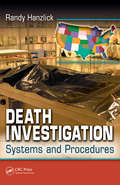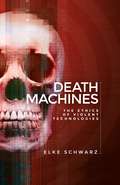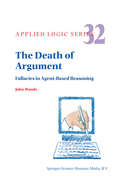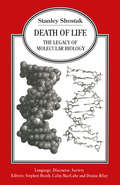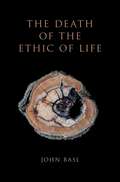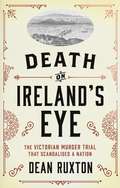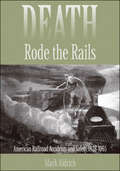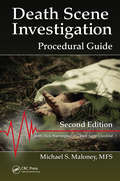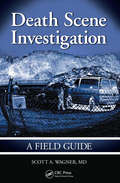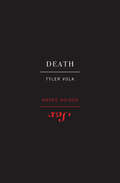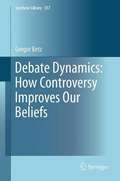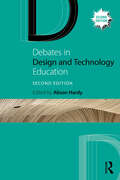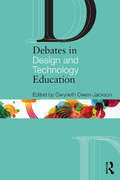- Table View
- List View
Death-Feigning in Insects: Mechanism and Function of Tonic Immobility (Entomology Monographs)
by Masaki SakaiThis book examines the mechanisms and functions of tonic immobility, the so-called death feigning behavior, or thanatosis, or animal hypnosis. The chapters cover the neurophysiological and experimental studies on insects, the functional significance of death-feigning, examination of the freezing and immobility behavior in insects through environment, physiology, genetics, and responses to ultrasound and vibration. It also covers tonic immobility and freezing behavior in fish from the perspective of vertebrates study.Tonic immobility is an interesting behavior that occurs reflexively in various animals under physical restraint by predators. The physiological mechanism of thanatosis was extensively investigated during 1960-1980. Researchers have proposed hypotheses to explain the mechanism underlying tonic immobility in vertebrates; local inhibition of the central nervous system, acceleration of the limbic system, abnormal control of the autonomic nervous system. On the other hand, the peripheral and central mechanisms of tonic immobility were intensely investigated at a behavioral and a neuronal level in stick insects and crickets. In the 1970s, behavioral ecology has shed light on the aspect of an ultimate factor for tonic immobility. Ethologists and ecologists challenged this matter in the laboratory and natural habitats, and have collected evidence for its functional roles using mainly insects such as beetles, moths, locusts. More recently, studies of tonic immobility in humans are drawing attention, as clinicians are trying to explain the defencelessness of rape victims from the viewpoint of animal hypnosis.This timely publication provides an understanding of the past and present research of the mechanisms and functions of tonic immobility. This book is intended for researchers and undergraduate/ graduate students in the field of zoology including physiology, ethology, ecology, and human behavior. It will also appeal to the public audience who has an interest in animal behavior, including human behavior.
Death in a Small Package: A Short History of Anthrax (Johns Hopkins Biographies of Disease)
by Susan D. JonesA disease of soil, animals, and people, anthrax has threatened lives for at least two thousand years. Farmers have long recognized its lasting virulence, but in our time, anthrax has been associated with terrorism and warfare. What accounts for this frightening transformation? Death in a Small Package recounts how this ubiquitous agricultural disease came to be one of the deadliest and most feared biological weapons in the world.Bacillus anthracis is lethal. Animals killed by the disease are buried deep underground, where anthrax spores remain viable for decades or even centuries and, if accidentally disturbed, can cause new infections. But anthrax can be deliberately aerosolized and used to kill—as it was in the United States in 2001. Historian and veterinarian Susan D. Jones recounts the life story of anthrax through the biology of the bacillus; the political, economic, geographic, and scientific factors that affect anthrax prevalance; and the cultural beliefs about the disease that have shaped human responses to it. She explains how Bacillus anthracis became domesticated, discusses what researchers have learned from numerous outbreaks, and analyzes how the bacillus came to be weaponized and what this development means for the modern world.Jones compellingly narrates the biography of this frightfully hardy disease from the ancient world through the present day.
Death in Classical Hollywood Cinema
by B. HaginBoaz Hagin carries out a philosophical examination of the issue of death as it is represented and problematized in Hollywood cinema of the classical era (1920s-1950s) and in later mainstream films, looking at four major genres: the Western, the gangster film, melodrama and the war film.
Death Investigation: An Introduction to Forensic Pathology for the Nonscientist
by Ann BucholtzDeath Investigation: An Introduction to Forensic Pathology for the Nonscientist provides students and law enforcement professionals with an accurate, clear overview of forensic pathology. It presents death investigation at the scene and autopsy, providing readers with a broad understanding of forensic pathology and giving them a clear picture of what happens after the examination of the scene. Readers learn what first responders should (and should not) do at the scene, and get a forensic pathologist's perspective on the importance of preserving evidence. Death Investigation methodically explains what happens during autopsy to determine cause and manner of death — including particulars of blunt force trauma, sharp force injuries, asphyxia, and gunshot wounds — and how findings are presented in court. Written for a criminal justice audience by a practicing forensic pathologist and educator, Death Investigation makes challenging forensics concepts accessible to nonscientists.
Death Investigation: An Introduction to Forensic Pathology for the Nonscientist
by Ann BucholtzDeath Investigation: An Introduction to Forensic Pathology for the Nonscientist provides students and law enforcement professionals with an accurate, clear overview of forensic pathology. It presents death investigation at the scene and autopsy, providing readers with a broad understanding of forensic pathology and giving them a clear picture of what happens after the examination of the scene. Readers learn what first responders should (and should not) do at the scene, and get a forensic pathologist's perspective on the importance of preserving evidence. Death Investigation methodically explains what happens during autopsy to determine cause and manner of death — including particulars of blunt force trauma, sharp force injuries, asphyxia, and gunshot wounds — and how findings are presented in court. Written for a criminal justice audience by a practicing forensic pathologist and educator, Death Investigation makes challenging forensics concepts accessible to nonscientists.
Death Investigation: Systems and Procedures
by Randy Hanzlick M.D.Death Investigation: Systems and Procedures is the first book dedicated to the topic of death investigation from a legal standpoint as well as the administrative and operational procedures that pertain to the medical examiner and the coroner system in the United States. Unique in its perspective, this book is the only one not concerned with instruc
Death machines: The ethics of violent technologies
by Elke SchwarzAs innovations in military technologies race toward ever-greater levels of automation and autonomy, debates over the ethics of violent technologies tread water. Death Machines reframes these debates, arguing that the way we conceive of the ethics of contemporary warfare is itself imbued with a set of bio-technological rationalities that work as limits. The task for critical thought must therefore be to unpack, engage, and challenge these limits. Drawing on the work of Hannah Arendt, the book offers a close reading of the technology-biopolitics-complex that informs and produces contemporary subjectivities, highlighting the perilous implications this has for how we think about the ethics of political violence, both now and in the future.
Death machines: The ethics of violent technologies
by Elke SchwarzDeath Machines offers a critical reconsideration of ethical theories and political justifications for technologised practices of violence in contemporary conflicts.
The Death of Argument: Fallacies in Agent Based Reasoning (Applied Logic Series #32)
by J.H. WoodsThe present work is a fair record of work I've done on the fallacies and related matters in the fifteen years since 1986. The book may be seen as a sequel to Fallacies: Selected papers 1972-1982, which I wrote with Douglas Walton, and which appeared in 1989 with Foris. This time I am on my own. Douglas Walton has, long since, found his own voice, as the saying has it; and so have I. Both of us greatly value the time we spent performing duets, but we also recognize the attractions of solo work. If I had to characterize the difference that has manifested itself in our later work, I would venture that Walton has strayed more, and I less, from what has come to be called the Woods-Walton Approach to the study of fallacies. Perhaps, on reflection "stray" is not the word for it, inasmuch as Walton's deviation from and my fidelity to the WWA are serious matters of methodological principle. The WWA was always conceived of as a way of handling the analysis of various kinds of fallacious argument or reasoning. It was a response to a particular challenge [Hamblin, 1970]. The challenge was that since logicians had allowed the investigation of fallacious reasoning to fall into disgraceful disarray, it was up to them to put things right. Accordingly, the WWA sought these repairs amidst the rich pluralisms of logic in the 1970s and beyond.
The Death of Death: The Scientific Possibility of Physical Immortality and its Moral Defense (Copernicus Books)
by José Cordeiro David WoodIs death inevitable? Until now, the history of mankind has been marked by this fatal fact. Religions, borders and progress are born from an ancient fear of death, comfort from this fear man often found only in religious paradigms. But according to José Luis Cordeiro and David Wood, the incontrovertible fact of death is no longer an absolute certainty - science and technology are preparing to tear down the final frontier: that of immortality.This accessible book provides insight into recent exponential advances in artificial intelligence, tissue regeneration, stem cell treatment, organ printing, cryopreservation, and genetic therapies that, for the first time in human history, offer a realistic chance to solve the problem of the aging of the human body. In this book, Cordeiro and Wood not only present all the major developments, initiatives, and ideas for eternal life, they also show why there are a number of good arguments for seeing death for what it is: the last undefeated disease.Enter any drugstore or bookstore, and we confronted with a mountain of nonsense concerning the aging process. Society seems obsessed with aging. That is why The Death of Death is such a refreshing delight, able to cut through the hype and reveal a balanced, authoritative, and lucid discussion of this controversial topic. It summarizes the astonishing breakthroughs made recently in revealing how science may one day conquer the aging process.Michio Kaku, theoretical physicist and author of The God Equation: The Quest for a Theory of Everything We are entering a Fantastic Voyage into life extension, crossing different bridges that will take us to indefinite life spans. The Death of Death explains clearly how we might soon reach longevity escape velocity and live long enough to live forever. Ray Kurzweil, co-author of Fantastic Voyage: Live Long Enough to Live Forever and co-founder of Singularity University The Death of Death is a truly revolutionary book. This is a visionary book that confronts us with the terrible reality of aging, and its authors are friends and connoisseurs of the subject. I believe that the authoritative and exhaustive description of this crusade that José and David make in this excellent book will accelerate this process. Forward! Aubrey de Grey, founder of LEV (Longevity Escape Velocity) Foundation and co-author of Ending Aging
Death of Life: The Legacy of Molecular Biology (Language, Discourse, Society)
by Stanley ShostakThe Death of Life dissects biology's claim to be the Cinderella science that rose above its station. Early attempts to study life through observation, experiment and theory are exposed as the skeleton of ideas for controlling life, ideas which were only fleshed out by the biotech and genomic industries. Physicists- and chemists-turned biologists in alliance with biology's own eugenicists are shown to have abandoned the study of life and suppressed poststructuralist approaches ranging from neoLamarckism to biogeological/Gaia theory.
The Death of the Ethic of Life
by John BaslMany subscribe to an Ethic of Life, an ethical perspective on which all living things deserve some level of moral concern. Within philosophy, the Ethic of Life has been clarified, developed, and rigorously defended; yet it has also found its harshest critics. Between biocentrists, those that endorse the Ethic of Life, and those that accept a more restricted view of moral status, the debate has reached a standstill, with few new resources for shifting or complicating it. In The Death of the Ethic of Life, John Basl seeks to end this comfortable stalemate by emphasizing a simple truth: the well-being of non-sentient beings, such as plants, species, and ecosystems, is morally significant only to the extent that it matters to sentient beings. Basl first develops a version of The Ethic of Life that best meets traditional challenges: the Ethic, if it is to survive criticism, must be able to explain how it is that all living things have a welfare or a good of their own. The best hope of offering such an explanation is to ground that welfare in teleology or goal-directedness, and then to ground that goal-directedness in the workings of natural selection. While a naturalistic account of teleology is crucial to defending an Ethic of Life, it is also its downfall. This Ethic ultimately entails that not only are ecosystems and collectives morally considerable, but so, too, are artifacts: everything from can openers to computers. Basl shows that evaluation of the resources for distinguishing artifacts from organisms forces us to abandon, for good, the Ethic of Life. The Death of the Ethic of Life provides not only a new answer to a fundamental question in environmental ethics, but a new way to conceive of fundamental concepts and issues in debates over who or what matters from the moral point of view, with wide-ranging implications in the philosophy of technology and bioethics.
The Death of the Ethic of Life
by John BaslMany subscribe to an Ethic of Life, an ethical perspective on which all living things deserve some level of moral concern. Within philosophy, the Ethic of Life has been clarified, developed, and rigorously defended; yet it has also found its harshest critics. Between biocentrists, those that endorse the Ethic of Life, and those that accept a more restricted view of moral status, the debate has reached a standstill, with few new resources for shifting or complicating it. In The Death of the Ethic of Life, John Basl seeks to end this comfortable stalemate by emphasizing a simple truth: the well-being of non-sentient beings, such as plants, species, and ecosystems, is morally significant only to the extent that it matters to sentient beings. Basl first develops a version of The Ethic of Life that best meets traditional challenges: the Ethic, if it is to survive criticism, must be able to explain how it is that all living things have a welfare or a good of their own. The best hope of offering such an explanation is to ground that welfare in teleology or goal-directedness, and then to ground that goal-directedness in the workings of natural selection. While a naturalistic account of teleology is crucial to defending an Ethic of Life, it is also its downfall. This Ethic ultimately entails that not only are ecosystems and collectives morally considerable, but so, too, are artifacts: everything from can openers to computers. Basl shows that evaluation of the resources for distinguishing artifacts from organisms forces us to abandon, for good, the Ethic of Life. The Death of the Ethic of Life provides not only a new answer to a fundamental question in environmental ethics, but a new way to conceive of fundamental concepts and issues in debates over who or what matters from the moral point of view, with wide-ranging implications in the philosophy of technology and bioethics.
Death on Earth: Adventures in Evolution and Mortality
by Mr Jules HowardThere is nothing more life-affirming than understanding death in all its forms.Natural selection depends on death; little would evolve without it. Every animal on Earth is shaped by its presence and fashioned by its spectre. We are all survivors of starvation, drought, volcanic eruptions, meteorites, plagues, parasites, predators, freak weather events, tussles and scraps, and our bodies are shaped by these ancient events. Some animals live for just a few hours as adults, others prefer to kill themselves rather than live unnecessarily for longer than they are needed, and there are a number of animals that can live for centuries. There are parasites that drive their hosts to die awful deaths, and parasites that manipulate their hosts to live longer, healthier lives. There is death in life.Amongst all of this, there is us, the upright ape; perhaps the first animal in the history of the universe fully conscious that death really is going to happen to us all in the end.With a narrative featuring a fish with a fake eye, the oldest animal in the world, the immortal jellyfish and some of the world's top death-investigating biologists, Death on Earth explores the never-ending cycle of death and the impact death has on the living, and muses on how evolution and death affect us every single day. Why are we so weird about death? Where does this fear come from? Why are we so afraid of ageing? And how might knowledge of ageing in other animals help us live better lives, free of the diseases of old age?
Death on Ireland's Eye: The Victorian Murder Trial that Scandalised a Nation
by Dean RuxtonA tragic death, a murder trial and a 170-year-old mystery – but what really happened?Shortly after Maria Kirwan died in a lonely inlet on Ireland’s Eye, it was decided that she had drowned accidentally during a day spent with her husband on the picturesque island. This inquest verdict appeared to conclude the melancholy events that consumed the fishing village of Howth, Co Dublin, in September 1852.But not long afterwards, suspicion fell upon Maria’s husband, William Burke Kirwan, as whispers of unspeakable cruelty, an evil character and a secret life rattled through the streets of Dublin. Investigations led to William's arrest and trial for murder.The story swelled into one of the most bitterly divisive chapters in the dark annals of Irish criminal history. Yet questions remain: Does the evidence stand up? What role did the heavy hand of Victorian moral outrage play? Was William really guilty of murder, or did the ever-present ‘moral facts’ fill in gaps where hard proof was absent?Now, this compelling modern analysis revisits the key evidence, asking sober questions about the facts, half-facts and fantasies buried within the yellowed pages of the Ireland’s Eye case files.
Death Receptors and Cognate Ligands in Cancer (Results and Problems in Cell Differentiation #49)
by Holger KalthoffDeath receptors play a central role in directing apoptosis in mammalian cells. This process of active cell death is important for a number of biological processes, e.g. for the regulation of the immune system. Death receptors are cell surface receptors that transmit apoptotic signals initiated by corresponding death ligands. Many complex signaling pathways are activated and apoptosis is the final result of a complex biochemical cascade of events. Besides their role in the induction of cell death, evidence now exists that death receptors are able to activate several non-apoptotic signaling pathways which, depending on cellular context, may lead to apoptosis resistance, secretion of pro-inflammatory proteins, proliferation and invasive growth of cancer cells. This book looks at the molecular basis of death receptor signaling and the role of death receptors in cancer development.
Death Rode the Rails: American Railroad Accidents and Safety, 1828–1965
by Mark AldrichFor most of the 19th and much of the 20th centuries, railroads dominated American transportation. They transformed life and captured the imagination. Yet by 1907 railroads had also become the largest cause of violent death in the country, that year claiming the lives of nearly twelve thousand passengers, workers, and others. In Death Rode the Rails Mark Aldrich explores the evolution of railroad safety in the United States by examining a variety of incidents: spectacular train wrecks, smaller accidents in shops and yards that devastated the lives of workers and their families, and the deaths of thousands of women and children killed while walking on or crossing the street-grade tracks. The evolution of railroad safety, Aldrich argues, involved the interplay of market forces, science and technology, and legal and public pressures. He considers the railroad as a system in its entirety: operational realities, technical constraints, economic history, internal politics, and labor management. Aldrich shows that economics initially encouraged American carriers to build and operate cheap and dangerous lines. Only over time did the trade-off between safety and output—shaped by labor markets and public policy—motivate carriers to develop technological improvements that enhanced both productivity and safety.A fascinating account of one of America's most important industries and its dangers, Death Rode the Rails will appeal to scholars of economics and the history of transportation, technology, labor, regulation, safety, and business, as well as to railroad enthusiasts.
Death Scene Investigation: Procedural Guide, Second Edition
by Michael S. MaloneyThose tasked with investigating death scenes come from a variety of backgrounds and varying levels of experience. Whether a homicide detective, crime scene investigator, medico-legal death investigator, coroner or medical examiner, Death Scene Investigation: Procedural Guide, Second Edition provides the investigator best-practice techniques and procedures for almost any death scene imaginable, including for deaths occurring even under the most unusual of circumstances. This Second Edition is fully updated to include new coverage on shallow graves, human remains at crime scenes, poisonings, expanded coverage of projectile weapons, videography, touch DNA, death notifications, and a newly added chapter dedicated to sexual deaths. In addition, the book serves as an on-scene ready reference which includes instructions on procedure including the initial notification of a death, processing the scene and body, the investigator's role at autopsy, and analyzing the scene indicators to place evidence into context. Topics discussed include: Initial response and scene evaluation Death scene management including documentation, sketching, photography, videography, observations, and search procedures A special death investigation matrix that walks the investigator though a decision tree to help in ambiguous deaths Contains discussion of all manners of death, including accident, suicide, natural and homicide Coverage of recovery of human remains from open field, aquatic, and buried sites including estimating the time of death. Wound dynamics and mechanisms of injury that covers asphyxiation, sharp and blunt force trauma, chopping injuries; handgun, rifle, and shotgun wounds, electrical injuries, and more The bulleted format and spiral binding allows for easy use and reference in the field with sections that are self-contained and cross-referenced for quick searches. With its thorough and detailed approach, Death Scene Investigation, Second Edition will be a must-have addition to any crime scene and death investigator’s tool kit.
Death Scene Investigation: Procedural Guide, Second Edition
by Michael S. MaloneyThose tasked with investigating death scenes come from a variety of backgrounds and varying levels of experience. Whether a homicide detective, crime scene investigator, medico-legal death investigator, coroner or medical examiner, Death Scene Investigation: Procedural Guide, Second Edition provides the investigator best-practice techniques and procedures for almost any death scene imaginable, including for deaths occurring even under the most unusual of circumstances. This Second Edition is fully updated to include new coverage on shallow graves, human remains at crime scenes, poisonings, expanded coverage of projectile weapons, videography, touch DNA, death notifications, and a newly added chapter dedicated to sexual deaths. In addition, the book serves as an on-scene ready reference which includes instructions on procedure including the initial notification of a death, processing the scene and body, the investigator's role at autopsy, and analyzing the scene indicators to place evidence into context. Topics discussed include: Initial response and scene evaluation Death scene management including documentation, sketching, photography, videography, observations, and search procedures A special death investigation matrix that walks the investigator though a decision tree to help in ambiguous deaths Contains discussion of all manners of death, including accident, suicide, natural and homicide Coverage of recovery of human remains from open field, aquatic, and buried sites including estimating the time of death. Wound dynamics and mechanisms of injury that covers asphyxiation, sharp and blunt force trauma, chopping injuries; handgun, rifle, and shotgun wounds, electrical injuries, and more The bulleted format and spiral binding allows for easy use and reference in the field with sections that are self-contained and cross-referenced for quick searches. With its thorough and detailed approach, Death Scene Investigation, Second Edition will be a must-have addition to any crime scene and death investigator’s tool kit.
Death Scene Investigation: A Field Guide
by Scott A. WagnerEach and every death scene presents new challenges to even the most seasoned investigator. Despite the unique nature of each scenario, using a standardized protocol is the key to ensuring consistent and accurate results. Death Scene Investigation: A Field Guide provides concise direction for the death scene investigator, crime scene investigator, c
Death & Sex
by Tyler Volk Dorion SaganOn DEATH . . . What is shared by spawning Pacific salmon, towering trees, and suicidal bacteria? In his lucid and concise exploration of how and why things die, Tyler Volk explains the intriguing ways creatures-including ourselves-use death to actually enhance life. Death is not simply the end of the living, though even in that aspect the Grim Reaper has long been essential to natural selection. Indeed, the exquisite schemes and styles of death that have emerged from evolution have been essential to the great story from life's beginnings in tiny bacteria nearly four thousand million years ago to ancient human rituals surrounding death and continuing to the existential concerns of human culture and consciousness today. Volk weaves together autobiography, biology, Earth history, and results of fascinating studies that show how thoughts of our own mortality affect our everyday lives, to prove how an understanding of what some have called the ultimate taboo can enrich the celebration of life. . . . and SEX In Sex, Dorion Sagan takes a delightful, irreverent, and informative romp through the science, philosophy, and literature of humanity's most obsessive subject. Have you ever wondered what the anatomy and promiscuous behaviors of chimpanzees and the sexual bullying of gorillas tell us about ourselves? Why we lost our hair? What amoebas have to do with desire? Linking evolutionary biology to salacious readings of the lives and thoughts of such notables as the Marquis de Sade and Simone de Beauvoir, and discussing works as varied as The Story of O and Silence of the Lambs, Sex touches on a potpourri of interrelated topics ranging from animal genitalia to sperm competition, the difference between nakedness and nudity, jealousy's status as an aphrodisiac and the origins of language, Casanova and music, ovulation and clothes, mother-in-law jokes and alpha females, love and loneliness. A brief, wonderfully entertaining, highly literate foray into the origins and evolution of sex. Two books in one cover, Death & Sex unravel and answer some of life's most fundamental questions.
Debate Dynamics: How Controversy Improves Our Beliefs (Synthese Library #357)
by Gregor BetzIs critical argumentation an effective way to overcome disagreement? And does the exchange of arguments bring opponents in a controversy closer to the truth? This study provides a new perspective on these pivotal questions. By means of multi-agent simulations, it investigates the truth and consensus-conduciveness of controversial debates. The book brings together research in formal epistemology and argumentation theory. Aside from its consequences for discursive practice, the work may have important implications for philosophy of science and the way we construe scientific rationality as well.
Debates in Design and Technology Education (Debates in Subject Teaching)
by Alison HardyDesign and technology is a relatively new subject compared to more traditional subjects, and during its brief existence, it has garnered widespread debate in schools. This book aims to explore some of these debates and challenges the reader with new perspectives about the subject by presenting and questioning arguments about the purpose, content and place of design and technology in the school curriculum. It will encourage the reader to critically reflect on their own beliefs and practices to reach informed judgements and perspectives that will affect how they teach and think about design and technology. Exploring the major issues that design and technology teachers encounter in their professional lives as well as introducing new topics they may never have considered before, this comprehensive second edition has been fully updated with 16 chapters focusing on emerging and enduring debates: How do we do race in design and technology? What’s so special about design and technology anyway? What is design cognition in design and technology classrooms? What is the potential of feedback in the creative processes of a design and technology classroom? Does food fit in design and technology? What is the role of making in design and technology? With its combination of expert opinion and fresh insight, Debates in Design and Technology Education is the ideal companion for any student or practising teacher engaged in initial training, continuing professional development or master’s-level study.
Debates in Design and Technology Education
by Gwyneth Owen-JacksonDesign and Technology has long held a controversial place on the school curriculum, with some arguing that it shouldn’t be there at all. This book presents and questions considered arguments and judgements, and explores the major issues that all D&T teachers encounter in their daily professional lives. In exploring some of the key debates, it encourages critical reflection and aims to stimulate both novice and experienced teachers to think more deeply about their practice, and link research and evidence to what they have observed in schools. Written by expert design and technology education professionals, chapters tackle established and contemporary issues, enabling you to reach informed judgements and argue your point of view with deeper theoretical knowledge and understanding. Debates covered include: What is the purpose of design and technology? Is it a vocational or academic subject? What is the place of design and technology within the STEM agenda? What knowledge and skills do teachers really need? What does the design and technology gender divide mean for schools and pupils? Is it a ‘creative’ subject? What is the future for design and technology? With its combination of expert opinion and fresh insight, Debates in Design and Technology Education is the ideal companion for any student or practising teacher engaged in initial training, continuing professional development or Masters level study.
Debates in Design and Technology Education
by Gwyneth Owen-JacksonDesign and Technology has long held a controversial place on the school curriculum, with some arguing that it shouldn’t be there at all. This book presents and questions considered arguments and judgements, and explores the major issues that all D&T teachers encounter in their daily professional lives. In exploring some of the key debates, it encourages critical reflection and aims to stimulate both novice and experienced teachers to think more deeply about their practice, and link research and evidence to what they have observed in schools. Written by expert design and technology education professionals, chapters tackle established and contemporary issues, enabling you to reach informed judgements and argue your point of view with deeper theoretical knowledge and understanding. Debates covered include: What is the purpose of design and technology? Is it a vocational or academic subject? What is the place of design and technology within the STEM agenda? What knowledge and skills do teachers really need? What does the design and technology gender divide mean for schools and pupils? Is it a ‘creative’ subject? What is the future for design and technology? With its combination of expert opinion and fresh insight, Debates in Design and Technology Education is the ideal companion for any student or practising teacher engaged in initial training, continuing professional development or Masters level study.
